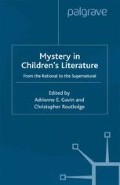Abstract
What literary figure could be more perverse than the child detective? In The Case of Peter Pan, Jacqueline Rose provocatively argues that juvenile literature, in order to maintain a notion of childhood innocence, ‘carries with it a plea that certain psychic barriers should go undisturbed, the most important of which is the barrier between adult and child’ (70). In these terms, the union of children’s fiction and detective fiction should be most disturbing, impossible even: detective mysteries require the lurid display of exactly the deceptions, instabilities, and corruptions of the adult world that children’s fiction supposedly seeks to keep from the young. Yet this union of literary forms, wherein juvenile investigators discover and probe the illicit doings of their elders, has proven to be one of the most popular, and resilient of generic innovations. The phenomenal success of the children’s mystery series produced by Edward Stratemeyer’s syndicate of ghostwriters (see Billman 1–35; Johnson 1–17), particularly the Nancy Drew novels, is only the most striking index of the widespread pleasure taken in challenging such deeply held beliefs about the necessary segregation of child and adult, mystery and certainty, innocence and experience.
Access this chapter
Tax calculation will be finalised at checkout
Purchases are for personal use only
Preview
Unable to display preview. Download preview PDF.
Works cited
Baden-Powell, Robert. Scouting for Boys: A Handbook for Instruction in Good Citizenship [1908], 7th edn. London: C. Arthur Pearson, 1915.
Billman, Carol. The Secret of the Stratemeyer Syndicate: Nancy Drew, the Hardy Boys, and the Million Dollar Fiction Factory. New York: Ungar, 1986.
Doyle, Arthur Conan. The Sign of the Four [1890], ed. Christopher Roden. Oxford: Oxford University Press, 1994.
Hoxie, W. J. How Girls Can Help Their Country. New York: Knickerbocker Press, 1913.
Inness, Sherrie A. ‘Girl Scouts, Camp Fire Girls, and Woodcraft Girls: ’Fhe Ideology of Girls’ Scouting Novels, 1910–1935’, in Ray B. Browne and Ronald J. Ambrosetti (eds), Continuities in Popular Culture: The Present in the Past and the Past in the Present and Future. Bowling Green, OH: Bowling Green State University Popular Press, 1993, pp. 229–40.
Inness, Sherrie A. (ed.) Nancy Drew and Company: Culture, Gender, and Girls’ Series. Bowling Green, OH: Bowling Green State University Popular Press, 1997.
Jaffe, Audrey. ‘Detecting the Beggar: Arthur Conan Doyle, Henry Mayhew, and “The Man with the Twisted Lip”’, Representations, 31 (1990): 96–117.
Johnson, Deidre. Edward Stratemeyer and the Stratemeyer Syndicate. Boston, MA: Twayne, 1993.
Jones, James P. ‘Nancy Drew, WASP Super Girl of the 1930’s, Journal of Popular Culture, 6 (1973): 707–17.
Kazin, Michael. The Populist Persuasion: An American History. New York: Basic-Harper Collins, 1995.
Keene, Carolyn. The Hidden Staircase 119–301. Bedford, MA: Applewood, 1991.
Keene, Carolyn. The Secret of the Old Clock [1930]. Bedford, MA: Applewood, 1991.
Keynes, John Maynard. The General Theory of Employment, Interest and Money [1936]. Volume 7 of The Collected Writings of John Maynard Keynes. London: Royal Economic Society/Macmillan/Cambridge University Press, 1973.
Mason, Bobbie Ann. The Girl Sleuth: A Feminist Guide. Old Westbury, NY: Feminist Press, 1975.
Moon, Michael. ’“The Gentle Boy from the Dangerous Classes”: Pederasty, Domesticity, and Capitalism in Horatio Alger’, Representations, 19 (1987): 87–110.
Parry, Sally E. ‘The Secret of the Feminist Heroine: The Search for Values in Nancy Drew and Judy Bolton’, in Sherrie A. Inness (ed.), Nancy Drew and Company: Culture, Gender, and Girls’ Series. Bowling Green OH: Bowling Green State University Popular Press 1997, pp. 145–58.
Potter, David M. People of Plenty: Economic Abundance and the American Character. Chicago: University of Chicago Press, 1954.
Prager, Arthur. Rascals at Large, or, The Clue in the Old Nostalgia. Garden City, NY: Doubleday, 1971.
Roosevelt, Franklin D. The Public Papers and Addresses of Franklin D. Roosevelt, ed. Samuel I. Rosenman, 13 vols. New York: Random/Macmillan/Harper, 1938–50.
‘Roosevelt Says Fair Play by Every Citizen Would End Most of America’s Problems’, Times (New York), 13 February 1934: 7.
Rose, Jacqueline. The Case of Peter Pan or The Impossibility of Children’s Fiction [1984], rev. edn. Philadelphia: University of Pennsylvania Press, 1993.
Scouting for Girls: Official Handbook of the Girl Scouts [1920], 6th rpt. New York: Girl Scouts, 1925.
Siegel, Deborah L. ‘Nancy Drew as New Girl Wonder: Solving It All for the 1930s’, in Sherrie A. Inness (ed.), Nancy Drew and Company: Culture, Gender, and Girls’ Series. Bowling Green, OH: Bowling Green State University Popular Press, 1997, pp. 159–82.
Tedesco, Laureen. ‘Making a Girl into a Scout: Americanizing Scouting for Girls’, in Sherrie A. Inness (ed.), Delinquents and Debutantes: Twentieth-Century American Girls’ Cultures. New York: New York University Press, 1998, pp. 19–39.
Twain, Mark. The Adventures of Tom Sawyer [1876], in Twain, Works, pp. 31–237.
Twain, Mark. Mark Twain’s Correspondence with Henry Huttleston Rogers 1893–1909, ed. Lewis Leary. Berkeley: University of California Press, 1969.
Twain, Mark. Tom Sawyer, Detective: As Told by Huck Finn [1896], in Twain, Works, pp. 357–415.
Twain, Mark. The Works of Mark Twain, vol. 4, eds John C. Gerber, Paul Baender and Terry Firkins. Iowa City: Iowa Center for Textual Studies; Berkeley: University of California Press, 1980.
Editor information
Editors and Affiliations
Copyright information
© 2001 Palgrave Macmillan, a division of Macmillan Publishers Limited
About this chapter
Cite this chapter
Boone, T. (2001). The Juvenile Detective and Social Class: Mark Twain, Scouting for Girls, and the Nancy Drew Mysteries. In: Gavin, A.E., Routledge, C. (eds) Mystery in Children’s Literature. Palgrave Macmillan, London. https://doi.org/10.1057/9780333985137_4
Download citation
DOI: https://doi.org/10.1057/9780333985137_4
Publisher Name: Palgrave Macmillan, London
Print ISBN: 978-1-349-42374-3
Online ISBN: 978-0-333-98513-7
eBook Packages: Palgrave Literature & Performing Arts CollectionLiterature, Cultural and Media Studies (R0)

